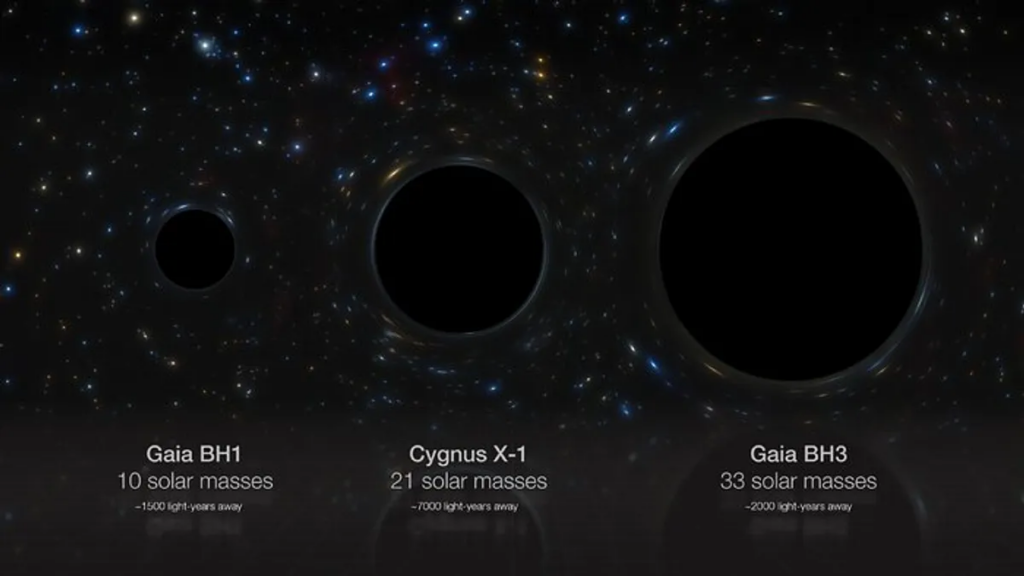The newly discovered black hole has a mass 33 times that of the Sun. This greatly exceeds the previous record for a stellar black hole in our galaxy, which was about 20 solar masses, and helped support theories about how an object of such mass could have formed.
The largest stars end their lives as supernovae, forming black holes from their catastrophic explosions. These black holes have much less mass than the stars from which they formed because so much was ejected during their lifetimes and during the supernova explosion.
Without a doubt, there are many such black holes hiding in our galaxy, which we have little chance to notice. Fortunately, a large number of exploding stars were part of binary systems, and sometimes even larger groups, when they lived. Some companions are ejected by the force of the supernova and wander the galaxy alone, but those that are more massive or more distant survive and orbit the black hole, alerting us to its presence.

When a regular oscillation of stars is observed, it means that they are affected by the gravity of some other object. Sometimes it could be a fainter star that we can't see, or even a planet, but in the case of a new discovery, that's impossible. The object that causes the star 2MASS J19391872+1455542 to make an 11,6-year circle has a mass thousands of times greater than the largest planet. If it were a star, it would be so bright that we could probably see it with the naked eye.
An invisible mass of this size would have to be a black hole – about 50 percent larger than Cygnus X-1, the previous largest known remnant of such an explosion in our galaxy.
The discovery was made by analyzing data from the Gaia telescope, which tracks the movements of stars with stunning precision. This is the third time that similar searches have led to similar discoveries, which is why the object was named Gaia BH3. Besides its enormous mass, Gaia BH3 is 2 light-years away in the constellation Aquila – not exactly nearby, but if the Milky Way were a large city, it would be the nearest suburb.
"No one expected to find a massive black hole lurking nearby that had not yet been discovered," Pasquale Panuzzo of the Paris Observatory said in a statement. "You can make such a discovery only once in your research life."
The Gaia observations themselves may have some other reason, but a large international team used the European Southern Observatory's Very Large Telescope (VLT) to confirm the measurements and reveal more.
One would expect that if such objects can be overlooked in our own galaxy, then we would know nothing about their presence elsewhere. Surprisingly, this is not the case. Gravitational waves alerted us to the existence of even larger stellar black holes billions of light years away. However, since this only works when two objects collide whose mutual orbits are disintegrating, this is very rare and we know of only a handful of cases, all of which have occurred at vast distances.
Astronomers' working hypothesis for such supermassive black holes, which have exceeded expectations, is that they come from very metal-poor stars: those formed almost entirely from hydrogen and helium that formed during the Big Bang. Such stars had the potential to be much more massive than those that exist in the modern universe. They are also thought to lose less mass through the stellar wind, saving it before forming black holes.
This idea makes sense, but we can't prove it using black holes detected with gravitational waves. That changed with the Gaia BH3. Stars in binary systems usually have a similar composition, except in rare cases where they did not form together, or, more commonly, when one star ate a planet large enough to significantly increase its metal content.
Using the VLT's UV-Vis Echelon Spectrograph, Dr. Elisabetta Kaffau and co-authors confirmed that J19391872+1455542 is indeed very metal-poor, making it likely that the star that became Gaia BH3 was the same. J19391872+1455542 is a very old star, as would be expected for such a metal-poor star, and despite being three-quarters the mass of the Sun, it has begun the process of becoming a red giant.
A full analysis of Gaia BH3 won't be done until at least late 2025, but the team behind the discovery wanted to give other astronomers a chance to look at it for themselves, maximizing the opportunity to learn more.


 118
118












